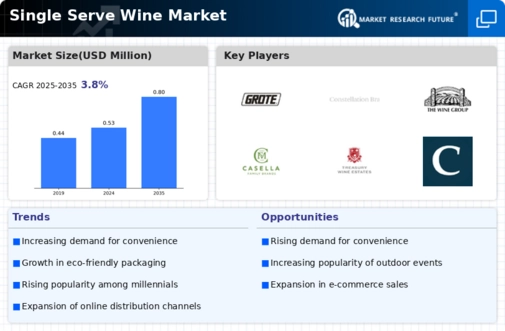Market Share
Single Serve Wine Market Share Analysis
The Single Serve Wine Market, with its individual-sized quantities, has grown in popularity, causing manufacturers to develop market share positioning strategies. Packaging innovation is a popular strategy. Single-serve wine brands typically use striking packaging to stand out. Creative, portable, and user-friendly packaging boost brand loyalty by improving consumer experience.
The Single Serve Wine Market is expected to grow the fastest between 2023 and 2032. Demographic and cultural changes drive Asia Pacific growth. Single-serve wine demand grows as customer tastes and lifestyles change. The region's growing middle class and preference for quick and personalized beverages drive the market's rapid growth.
Cultural influences influence consumption patterns, with single-serve wine becoming more popular as society standards change. Asia Pacific's urbanization and fast-paced lives drive demand for single-serve wine. These factors drive the market's growth, making Asia Pacific a key location for industry companies looking to profit on the Single Serve Wine Market's changing dynamics. In this fast-growing business, smart modifications to regional tastes and cultural differences will determine success. Pricing methods also affect Single Serve Wine Market share. Companies may provide competitive pricing to attract cost-conscious customers and increase market share. Premium brands may charge more to position themselves as luxury options and target a niche clientele that values uniqueness and quality over price.
Market share positioning also depends on distribution networks. To boost product awareness, companies may cooperate with shops. Brands may reach more customers by targeting high-traffic online and physical places. By partnering with prominent platforms or events, brands may increase their visibility and promote their single-serve wines.
Brand positioning is another important part of Single Serve Wine Market share strategy. A distinct brand identity that connects with customers builds trust and loyalty. Eco-friendly methods, organic and sustainable sourcing, and a personal brand story may help. Companies may stand out in a competitive market and win loyal customers by creating a unique brand image.
Product innovation is key to staying competitive in the Single Serve Wine Market. Many brands spend in R&D to offer novel tastes, mixes, or packaging innovations to meet consumer preferences. Brands that provide innovative and intriguing products attract and keep customers.
Effective marketing and promotional operations boost market share. Social media, influencers, and compelling narrative may boost a brand's exposure and buzz around its single-serve wine products. Clever marketing methods that showcase the brand's distinctive characteristics, advantages, and values can impact consumer perceptions and drive trial and repeat sales.











Leave a Comment